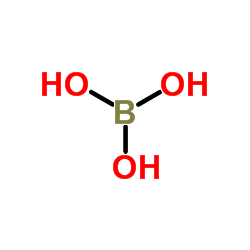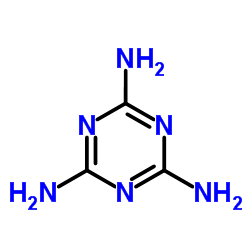Boron nitride

Boron nitride structure
|
Common Name | Boron nitride | ||
|---|---|---|---|---|
| CAS Number | 10043-11-5 | Molecular Weight | 24.818 | |
| Density | 2.29 | Boiling Point | N/A | |
| Molecular Formula | BH2N | Melting Point | 2700ºC (sublimes) | |
| MSDS | Chinese USA | Flash Point | N/A | |
| Name | boron nitride |
|---|---|
| Synonym | More Synonyms |
| Density | 2.29 |
|---|---|
| Melting Point | 2700ºC (sublimes) |
| Molecular Formula | BH2N |
| Molecular Weight | 24.818 |
| Exact Mass | 25.012381 |
| PSA | 23.79000 |
| Index of Refraction | 1.728 |
| Storage condition | -20°C |
| Stability | Stable. Incompatible with oxidizing agents, water. |
|
Version 1.4
Regulation (EC) No 1907/2006 1 - Product and Company Information Product NameBORON NITRIDE, POWDER, CA. 1 MICRON, 98% 2 - Hazards Identification SPECIAL INDICATION OF HAZARDS TO HUMANS AND THE ENVIRONMENT Irritating to eyes and respiratory system.
3 - Composition/Information on Ingredients Product NameCAS #EC noAnnex I Index Number BORON NITRIDE10043-11-5 233-136-6 None FormulaBN Molecular Weight 24,8200 AMU SynonymsBN 40SHP * Borazon * Boron mononitride * BZN 550 * Denka boron nitride GP * Denka GP * Elbor * Elbor LO 10B1-100 * Elboron * Elbor R * Elbor RM * Geksanit R * Hexanite R * Hexanit R * KBN-H10 * Kubonit * Kubonit KR * Sho BN * Sho BN HPS * SP 1 * SP 1 (Nitride) * Super mighty M * UHP-Ex * Wurzin 4 - First Aid Measures AFTER INHALATION If inhaled, remove to fresh air. If not breathing give artificial respiration. If breathing is difficult, give oxygen. AFTER SKIN CONTACT In case of contact, immediately wash skin with soap and copious amounts of water. AFTER EYE CONTACT In case of contact, immediately flush eyes with copious amounts of water for at least 15 minutes. AFTER INGESTION ALDRICHwww.molbase.com If swallowed, wash out mouth with water provided person is conscious. Call a physician. 5 - Fire Fighting Measures EXTINGUISHING MEDIA Suitable: Noncombustible. Use extinguishing media appropriate to surrounding fire conditions. SPECIAL RISKS Specific Hazard(s): Emits toxic fumes under fire conditions. SPECIAL PROTECTIVE EQUIPMENT FOR FIREFIGHTERS Wear self-contained breathing apparatus and protective clothing to prevent contact with skin and eyes. 6 - Accidental Release Measures PROCEDURE(S) OF PERSONAL PRECAUTION(S) Wear respirator, chemical safety goggles, rubber boots, and heavy rubber gloves. METHODS FOR CLEANING UP Sweep up, place in a bag and hold for waste disposal. Avoid raising dust. Ventilate area and wash spill site after material pickup is complete. 7 - Handling and Storage HANDLING Directions for Safe Handling: Do not breathe dust. Avoid contact with eyes, skin, and clothing. Avoid prolonged or repeated exposure. STORAGE Conditions of Storage: Keep container closed. Store in a cool dry place. SPECIAL REQUIREMENTS: Hygroscopic. 8 - Exposure Controls / Personal Protection ENGINEERING CONTROLS Safety shower and eye bath. Mechanical exhaust required. GENERAL HYGIENE MEASURES Wash thoroughly after handling. PERSONAL PROTECTIVE EQUIPMENT Special Protective Measures: Wear appropriate government approved respirator, chemical-resistant gloves, safety goggles, other protective clothing. 9 - Physical and Chemical Properties AppearanceColor: Faintly beige Form: Powder PropertyValueAt Temperature or Pressure ALDRICHwww.molbase.com pH N/A BP/BP RangeN/A MP/MP RangeN/A Flash PointN/A FlammabilityN/A Autoignition TempN/A Oxidizing Properties N/A Explosive Properties N/A Explosion LimitsN/A Vapor PressureN/A SG/Density2,2900 g/cm3 Partition Coefficient N/A ViscosityN/A Vapor DensityN/A Saturated Vapor Conc. N/A Evaporation RateN/A Bulk DensityN/A Decomposition Temp.N/A Solvent ContentN/A Water ContentN/A Surface TensionN/A ConductivityN/A Miscellaneous DataN/A SolubilityN/A 10 - Stability and Reactivity STABILITY Conditions of Instability: Moisture. Conditions to Avoid: Moisture. Materials to Avoid: Strong oxidizing agents. HAZARDOUS DECOMPOSITION PRODUCTS Hazardous Decomposition Products: Nature of decomposition products not known. HAZARDOUS POLYMERIZATION Hazardous Polymerization: Will not occur 11 - Toxicological Information RTECS NUMBER: ED7800000 SIGNS AND SYMPTOMS OF EXPOSURE To the best of our knowledge, the chemical, physical, and toxicological properties have not been thoroughly investigated. ROUTE OF EXPOSURE Skin Contact: May cause skin irritation. Eye Contact: Causes eye irritation. Inhalation: Material is irritating to mucous membranes and upper respiratory tract. Multiple Routes: May be harmful by inhalation, ingestion, or skin absorption. 12 - Ecological Information No data available. 13 - Disposal Considerations ALDRICHwww.molbase.com SUBSTANCE DISPOSAL Bury in a landfill site approved for the disposal of chemical and hazardous wastes. Observe all federal, state, and local environmental regulations. 14 - Transport Information RID/ADR Non-hazardous for road transport. IMDG Non-hazardous for sea transport. IATA Non-hazardous for air transport. 15 - Regulatory Information CLASSIFICATION AND LABELING ACCORDING TO EU DIRECTIVES INDICATION OF DANGER: Xi Irritant. R-PHRASES: 36/37 Irritating to eyes and respiratory system. S-PHRASES: 26-36 In case of contact with eyes, rinse immediately with plenty of water and seek medical advice. Wear suitable protective clothing. COUNTRY SPECIFIC INFORMATION Germany WGK: 3 Self-Classification 16 - Other Information WARRANTY The above information is believed to be correct but does not purport to be all inclusive and shall be used only as a guide. The information in this document is based on the present state of our knowledge and is applicable to the product with regard to appropriate safety precautions. It does not represent any guarantee of the properties of the product. Inc., shall not be held liable for any damage resulting from handling or from contact with the above product. See reverse side of invoice or packing slip for additional terms and conditions of sale. Copyright 2010 Co. License granted to make unlimitedpaper copies for internal use only. DISCLAIMER For R&D use only. Not for drug, household or other uses. ALDRICHwww.molbase.com SECTION 16 - ADDITIONAL INFORMATION N/A |
CHEMICAL IDENTIFICATION
HEALTH HAZARD DATAACUTE TOXICITY DATA
|
| Personal Protective Equipment | dust mask type N95 (US);Eyeshields;Gloves |
|---|---|
| Hazard Codes | Xi:Irritant |
| Risk Phrases | R36/37 |
| Safety Phrases | S26-S36 |
| RIDADR | UN1950 |
| RTECS | ED7800000 |
| Hazard Class | 2.1 |
| Precursor 10 | |
|---|---|
| DownStream 10 | |
|
Seamless Rim-Functionalization of h-BN with Silica-Experiment and Theoretical Modeling.
Chemistry 21 , 7662-7, (2015) Boron nitride contains six-ring layers, which are isostructural to graphene, and it exhibits similar extraordinary mechanical strength. Unlike graphene, hexagonal boron nitride (h-BN) is an insulator ... |
|
|
A monomeric [Zr(CO3)4](4-) complex in an ammonium zirconium carbonate aqueous solution studied by extended X-ray absorption fine structure, Raman and nuclear magnetic resonance spectroscopy.
Dalton Trans. 44(2) , 645-52, (2014) The speciation of zirconium complexes in ammonium zirconium carbonate (AZC) solutions should be further studied in order to develop high-performance AZC complexes for use in elaborate industrial mater... |
|
|
Heteropentanuclear Oxalato-Bridged nd-4f (n=4, 5) Metal Complexes with NO Ligand: Synthesis, Crystal Structures, Aqueous Stability and Antiproliferative Activity.
Chemistry 21 , 13703-13, (2015) A series of heteropentanuclear oxalate-bridged Ru(NO)-Ln (4d-4f) metal complexes of the general formula (nBu4N)5[Ln{RuCl3(μ-ox)(NO)}4], where Ln=Y (2), Gd (3), Tb (4), Dy (5) and ox=oxalate anion, wer... |
| shobn |
| Nitriloborane |
| Boron nitride |
| boron niride |
| EINECS 233-136-6 |
| boron nitrides |
| BN F15 |
| elborr |
| BN C |
| MFCD00011317 |
| BN B50 |
| BN A01 |
| uhp-ex |
| Borane, nitrilo- |
| wurzin |
| bzn550 |
| elbor |
 CAS#:7664-41-7
CAS#:7664-41-7 CAS#:11113-50-1
CAS#:11113-50-1 CAS#:6569-51-3
CAS#:6569-51-3 CAS#:78837-91-9
CAS#:78837-91-9 CAS#:108-78-1
CAS#:108-78-1 CAS#:19287-45-7
CAS#:19287-45-7 CAS#:57-13-6
CAS#:57-13-6 CAS#:10294-34-5
CAS#:10294-34-5 CAS#:7637-07-2
CAS#:7637-07-2 CAS#:7727-37-9
CAS#:7727-37-9 CAS#:2551-62-4
CAS#:2551-62-4 CAS#:108203-18-5
CAS#:108203-18-5 CAS#:1333-74-0
CAS#:1333-74-0 CAS#:41517-42-4
CAS#:41517-42-4
